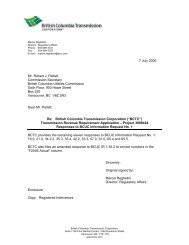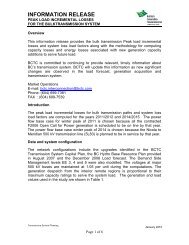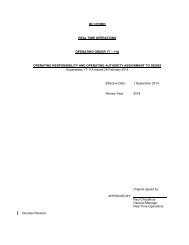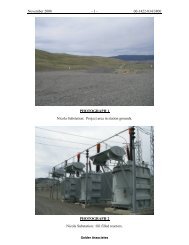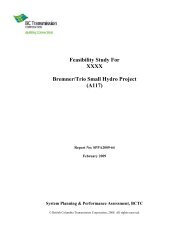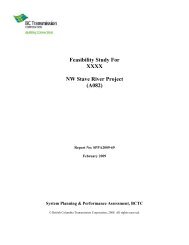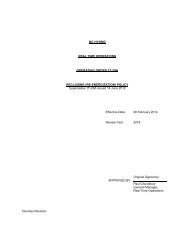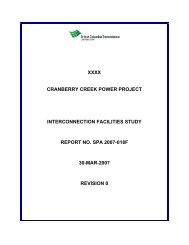Evidence on the Adequacy of First Nations Consultation - BC Hydro ...
Evidence on the Adequacy of First Nations Consultation - BC Hydro ...
Evidence on the Adequacy of First Nations Consultation - BC Hydro ...
Create successful ePaper yourself
Turn your PDF publications into a flip-book with our unique Google optimized e-Paper software.
authority, <strong>the</strong> basis <strong>of</strong> Indian allotments, if allowed in <strong>the</strong> first place, was reduced to a maximum <strong>of</strong><br />
ten acres per family, even though standard pre-empti<strong>on</strong>s for settlers were set at 160 acres.<br />
Although some B.C. lands were set aside for Indians during <strong>the</strong> col<strong>on</strong>ial period, this was not <strong>the</strong> case<br />
in <strong>the</strong> Kootenay regi<strong>on</strong>. It was not until <strong>the</strong> entry into <strong>the</strong> Domini<strong>on</strong> <strong>of</strong> Canada by <strong>the</strong> Crown Col<strong>on</strong>y<br />
<strong>of</strong> British Columbia in 1871 and <strong>the</strong>ir agreement to transfer resp<strong>on</strong>sibility for Indian matters to <strong>the</strong><br />
Domini<strong>on</strong> through Article 13 that reserve allotments were made for all groups recognized by Canada<br />
and B.C. as Indian bands. For <strong>the</strong> Ktunaxa, <strong>the</strong>se allotments were made primarily in <strong>the</strong> 1880s.<br />
However, <strong>the</strong>se restrictive allotments <strong>of</strong> land under <strong>the</strong> reserve system combined with range land<br />
alienati<strong>on</strong>, cultural suppressi<strong>on</strong> by Federal and Residential School <strong>of</strong>ficials and disrupti<strong>on</strong> <strong>of</strong> fisheries<br />
resources have severely disrupted <strong>the</strong> traditi<strong>on</strong>al way <strong>of</strong> life <strong>of</strong> <strong>the</strong> Ktunaxa.<br />
8. TRADITIONAL TERRITORY OF THE KTUNAXA AS SEEN BY EARLY EUROPEANS<br />
The journals, letters and reports <strong>of</strong> <strong>the</strong> Plateau’s earliest fur traders and to a lesser extent its<br />
missi<strong>on</strong>aries, land surveyors and independent adventurers, are a major source <strong>of</strong> our understanding <strong>of</strong><br />
<strong>the</strong> extent <strong>of</strong> <strong>the</strong> territory traditi<strong>on</strong>ally c<strong>on</strong>trolled by <strong>the</strong> Ktunaxa. While <strong>the</strong>ir role included ga<strong>the</strong>ring<br />
intelligence c<strong>on</strong>cerning <strong>the</strong> habits and territories <strong>of</strong> <strong>the</strong> Indians <strong>the</strong>y encountered, <strong>the</strong>ir journals<br />
writings are <strong>of</strong>ten sparse and imprecise in this regard but never<strong>the</strong>less have provided valuable<br />
insights into aboriginal world <strong>of</strong> <strong>the</strong> Columbia Plateau at this time.<br />
David Thomps<strong>on</strong><br />
Arguably <strong>the</strong> best known and certainly <strong>the</strong> most celebrated <strong>of</strong> all <strong>the</strong> European trader/explorers in <strong>the</strong><br />
area, Thomps<strong>on</strong> was <strong>the</strong> first literate trader to encounter <strong>the</strong> Ktunaxa in <strong>the</strong>ir homeland west <strong>of</strong> <strong>the</strong><br />
Divide. He and o<strong>the</strong>rs in <strong>the</strong> North West Company realized that a rich source <strong>of</strong> furs lay to <strong>the</strong> west<br />
<strong>of</strong> <strong>the</strong> Rocky Mountains in Ktunaxa territory and, inspired by <strong>the</strong> establishment <strong>of</strong> maritime trading<br />
posts at <strong>the</strong> mouth <strong>of</strong> <strong>the</strong> Columbia and Alexander MacKenzie’s recent voyage to <strong>the</strong> Pacific in 1793,<br />
<strong>the</strong>y determined to cross <strong>the</strong> mountains and tap into that potential pr<strong>of</strong>it.<br />
The opening through <strong>the</strong> Blackfoot blockade began when Thomps<strong>on</strong>, hearing that a Ktunaxa party<br />
was in <strong>the</strong> mountains nearby, went to meet <strong>the</strong>m and proposed a visit by <strong>the</strong>m to <strong>the</strong> local North West<br />
post. 29 This led to a plan as described by fur trader Peter Fidler: 30<br />
In <strong>the</strong> fall <strong>of</strong> 1800, 28 Cott<strong>on</strong> n haw men with 2 Women came into Act<strong>on</strong> House, our uppermost<br />
settlement in <strong>the</strong> Saskatchewan river, with a few furrs [sic] – this is <strong>the</strong> first time <strong>the</strong>y have ever seen a<br />
House. After remaining here for a few days (no o<strong>the</strong>r Indians being near <strong>the</strong> house) 2 Canadians<br />
accompanied <strong>the</strong>m to <strong>the</strong>ir Country to examine it & learn whe<strong>the</strong>r or not any Beaver in any quantity<br />
was to be found <strong>the</strong>re – but as <strong>the</strong>se two men could nei<strong>the</strong>r read nor write, what remarks <strong>the</strong>y made was<br />
merely verbal…They arrived at <strong>the</strong> House…<strong>on</strong> <strong>the</strong> 23 rd <strong>of</strong> May 1801.<br />
Thomps<strong>on</strong> and Fidler had successfully c<strong>on</strong>spired to have <strong>the</strong> French Canadians, Le Blanc and La<br />
Gasse [Legace], slip undetected through <strong>the</strong> Rockies and <strong>the</strong>y lived periodically with <strong>the</strong> Ktunaxa in<br />
29 From The Manuscript Journals <strong>of</strong> Alexander Henry and <strong>of</strong> David Thomps<strong>on</strong>, ed. by Elliott Coues [1897]; pp. 703-704.<br />
30 H<strong>BC</strong>A E3/2; Act<strong>on</strong> [Old Act<strong>on</strong>] House later became known as Rocky Mountain House.<br />
16<br />
Page 160 <strong>of</strong> 200






